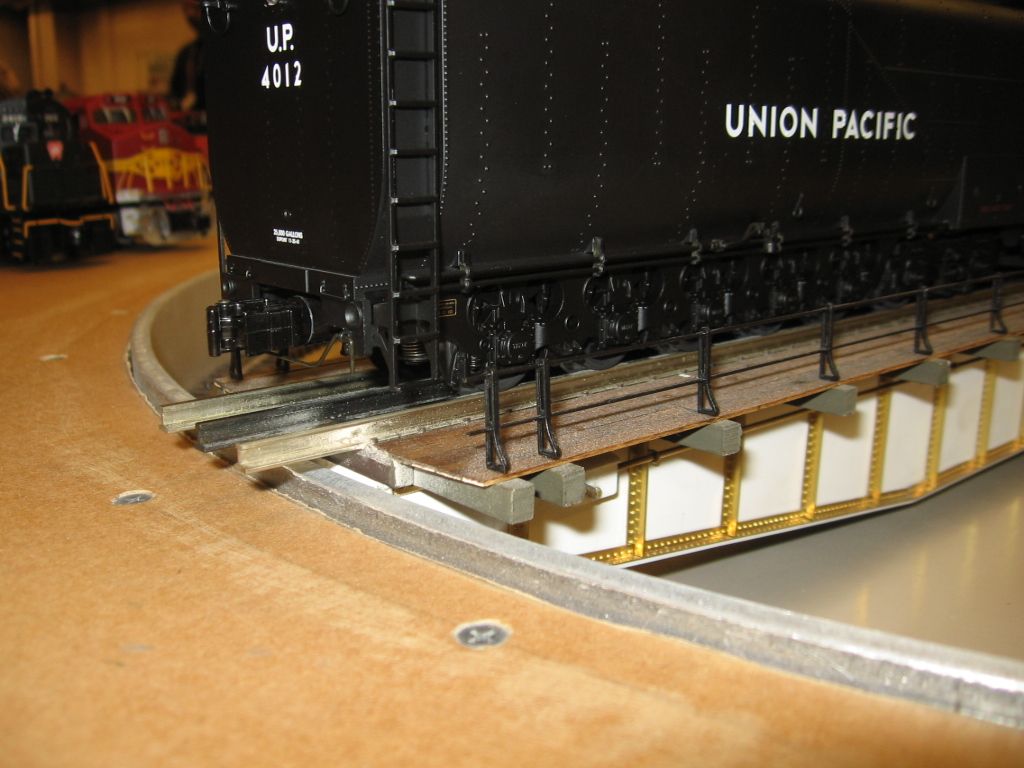The 22" turntable on my layout is too short--really needs to be 25". Which raises the question, did protoptype railroads, when conffronted with a too-short turntable, ever add extensions without enlarging the pit?
Replies sorted oldest to newest
When the Pennsy leased Santa Fe 2-10-4's in 1956, huge metal extensions were fastened to the turntable track to lift the end of those immense tenders. That was a stopgap measure. I'm certain that railroads usually installed longer turntables to accommodate larger locomotives, as the UP did for Big Boys. The turntable at The Railroad Museum of Pennsylvania had been installed by the Reading to turn 110' T-1 4-8-4's.
To turn that T-1, you would need a 28" O scale turntable. How long is a Big Boy, and the D&RGW 4-8-8-4 3rd Rail is offering? Need turntables HOW long, in inches? I am just planning on a couple of armstong turntables, but not for big articulateds.
colorado hirailer posted:To turn that T-1, you would need a 28" O scale turntable. How long is a Big Boy, and the D&RGW 4-8-8-4 3rd Rail is offering? Need turntables HOW long, in inches?
Should be at least 32" long for the largest articulated models. My old Bowser 32" table turns everything, although the pilot and rear of the tender hangs off either end, just like the prototype.
I am just planning on a couple of armstong turntables, but not for big articulateds.
RJR posted:The 22" turntable on my layout is too short--really needs to be 25". Which raises the question, did protoptype railroads, when conffronted with a too-short turntable, ever add extensions without enlarging the pit?
Yep.
How to turn a Santa Fe 2-10-4 on a Pennsy turntable:
Rusty
Attachments
Rather than extending your turntable, you may want to consider creating a through track across the turntable to the other side, long enough for your longer engine(s). Here's a picture of mine. I added an engine shed at the end of the track. I made the track long enough to store a couple of engines:
Attachments
I saw a few pix of that loco being turned, but not too practical on aa layout.
stangtrain posted:Rather than extending your turntable, you may want to consider creating a through track across the turntable to the other side, long enough for your longer engine(s). Here's a picture of mine. I added an engine shed at the end of the track. I made the track long enough to store a couple of engines:
All well and good except,,,,,,how do you actually "turn" a locomotive 180 degrees?
Maybe the easiest solution (although not very exciting) is to do what real railroads had to do at times, and build a wye track. I know, I know space is at a premium on most layouts. I guess that's why I'm an HO man. ![]()
I don't want to make this a layout-building thread---just looking for prototypes. Has anyone seen, either in the flesh or in photos, where a railroad, to avoid enlarging a pit, had the turntable tracks extend beyond the pit, supported by some type of structure on the turntable, like plate girders?
Wouldn't all the other tracks then have to be built up to meet the overhang on the turntable? Doesn't sound very feasible to me.....
Yes. But over the years railroads, especially smaller or more impoverished ones, have made many unusual modifications to their facilities.![]() Pictures of unusual modifications have graced the OGR forum and various magazines for years.
Pictures of unusual modifications have graced the OGR forum and various magazines for years.![]() Perhaps a forumite has seen one and can pass it on????
Perhaps a forumite has seen one and can pass it on????![]()
Dieselbob posted:Wouldn't all the other tracks then have to be built up to meet the overhang on the turntable? Doesn't sound very feasible to me.....
Not to mention, what would support the weight of such an "overhang"?
RJR posted:Yes. But over the years railroads, especially smaller or more impoverished ones, have made many unusual modifications to their facilities.
Pictures of unusual modifications have graced the OGR forum and various magazines for years.
Perhaps a forumite has seen one and can pass it on????
OK, I'll bite. Would a road that small or that impoverished even HAVE a locomotive big enough to require this type of Rube Goldberg fix?
A Diamond Scale TT. Bridge rail is 26.5" Weaver Pennsy M1a/b with long haul tender.



This scratch built TT has 31" Bridge rails. Two Weaver Alco C630's. Fort Pitt High Railers modular layout.

With a Lionel Big Boy.



Two Atlas Dash 8 40BW's

Dieselbob: Are you saying it's not possible?
MikeCT: I see your turntable tracks do overhang.
Hot Water: plate girders might suffice. There are pix on internet of turntables using above-track plate girders.




